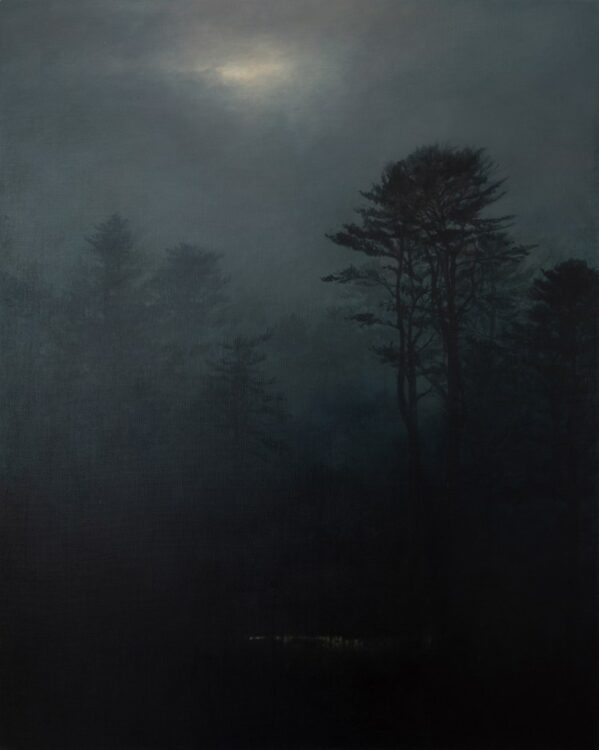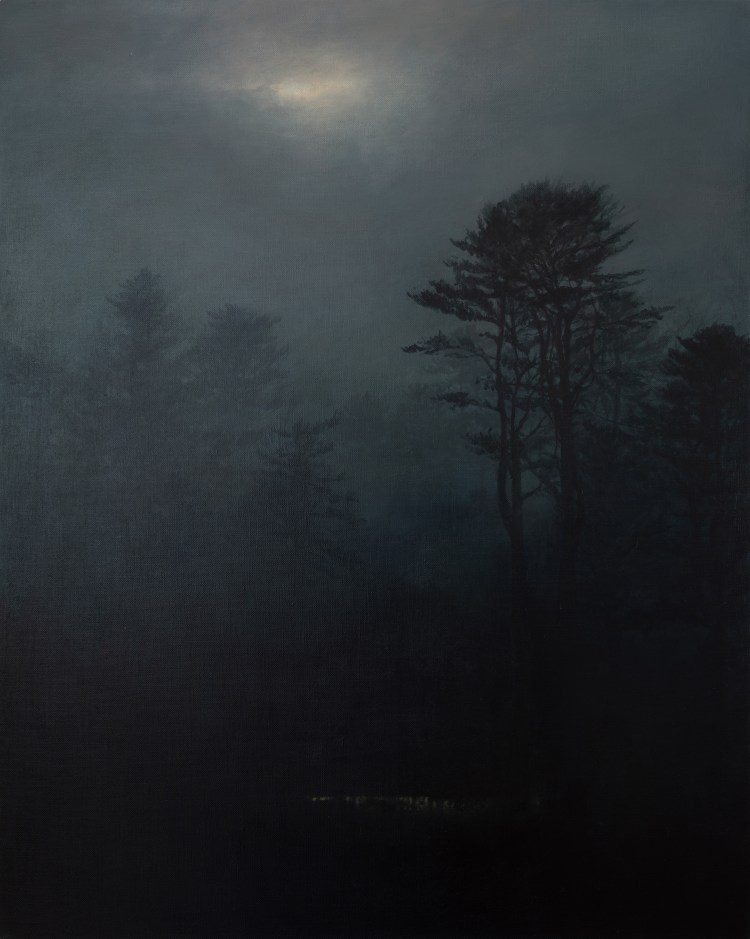

Dozier Bell, “Vernal Pool,” 40” x 32,” acrylic on linen, 2024 Photo by David Clough
As the summer winds down, there are some wonderful small shows ushering us into fall in Woolwich, Monson and Portland.
Dozier Bell is an artist of such technical skill that the considerable impact of her show at Sarah Bouchard Gallery in Woolwich, “Genius loci” (through Sept. 15), is not exactly a surprise. To say she is a hyperrealist painter is an understatement, particularly when speaking of her charcoal works on Mylar, which, stare as you may, insist on convincing you they are really black-and-white photographs.
But Bell is after a lot more than just photographic verisimilitude. She is an artist acutely interested in the dying of the light, and the many effects created in that liminal hour between day and night, when details become difficult to discern and contours blur and dissolve into darkness and shadow. The dexterity with which she portrays the physical qualities of the gloaming are breathtaking. Yet the reason they pack such a visceral punch is because what she gets right, beyond these objective elements, is the actual emotional affect of this hour.
The sense of a cycle ending, along with its attendant melancholy, is here. The wooziness we experience as we try to continue focusing on particulars even as we are defeated by the tenebrous light is here. The sense of the sky’s weight above us, the fuzzy glow of a moon behind mist, the silence that falls as birds cease their chirping and cooing, the awakening of night peepers and crickets … it’s all here. Just look at “Vernal Pool,” an acrylic on linen, and try to dispel any of the sensations mentioned above.
In the oil on panel “March night, Bowman Island,” the silvery moonlight on water evokes both the frigidness of the scene and its peaceful, shimmering beauty. One of the most astonishing works is the tiny charcoal-on-Mylar “Pines near the river.” Perhaps it is the luminosity of the Mylar, a reflective and stubbornly nonporous surface, that gives the light emerging from a bank of clouds its almost holy radiance. But if we look closely at this work, or others like “Oculus, clearing, 2” and “Smoke,” we realize that yes, this plays a role, but Bell achieves it, moreover, by masterful use of white charcoal and the way she mixes it with black to form a broad spectrum of blacks, grays and whites.
These works invite a certain kind of viewing, one that requires you to drop your shoulders, become meditative and surrender. That’s a lot more in Bell’s work than mere adroitness of medium and technique could ever suggest.
TREE-HUGGING IN MONSON
As a sleepy town a little over two hours from Portland and cheek by jowl to the Appalachian Trail, Monson doesn’t have the constant rotation of exhibits of a city. Two shows up right now are good examples: “Berenice Abbott’s Greenwich Village” (at Monson Arts Gallery through Sept. 15), which features a portfolio of portraits and street scenes of the bohemian New York enclave by the famous photographer who lived the last years of her life in nearby Blanchard, and “Tree Talk” (which takes us right up to the end of 2024 on Dec. 31) at Monson Pottery/Gascoine Gallery.
The Abbott show and its backstory were featured in the Press Herald/Maine Sunday Telegram last month. The Monson Pottery/Gascoine Gallery show is, as the title indicates, all about trees and the myriad forms the subject takes, which is presented through multiple media, including painting, sculpture, photography, fiber art, book arts, ceramics and so on. It ranges from whimsical and fun to serious and physically imposing, giving us an enormous range of ways to look at and reconsider this essential – and, in the human mind, symbolic – element of nature.
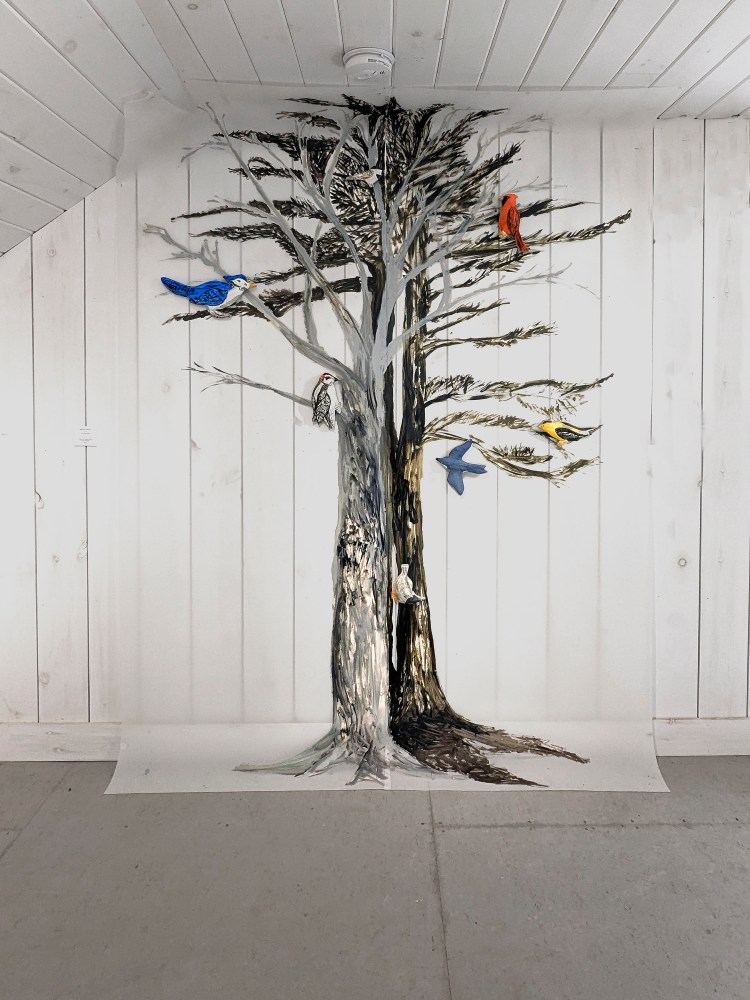

Barbara Sullivan’s fresco at Gascoine Gallery in Monson. Photo courtesy of Todd Watts
Maine, according to the exhibition statement, is the most forested state in the union, and many people in the area make their living from trees in one way or another: making paper, crafting furniture, harvesting and selling wood, etc.
At the whimsical end are Barbara Sullivan’s frescoes of birds, which she perched in a tree she painted against the wall at the top of the stairs. It is a charming piece, the fresco medium allowing her to represent various avian species in a colorful accessible way.
They can recall our childhood memories and depictions of jays, cardinals, woodpeckers, et alia. But it also reminds us of trees’ role as vital habitats for the survival of all species.
Susie Brandt’s colorful rip-stock banners of a tree stump also come off as cheery, mainly due to the bright color. But clearly this tree has been cut down, a jagged portion of it still protruding from the cleanly sawn surface.
Some works can feel slightly eerie, as with Todd Watts’ “Copse Caper,” a manipulated photo of a Hitchcockian flock of birds swarming through a stand of trees on a snowy winter night. Or there are Jonty Sale’s surreal photo of a forest with what seems like another image of felled trees ghosted within it, and his “Animal Trees,” in which he has digitally played with three images to create what looks like animal spirits living within the trees.
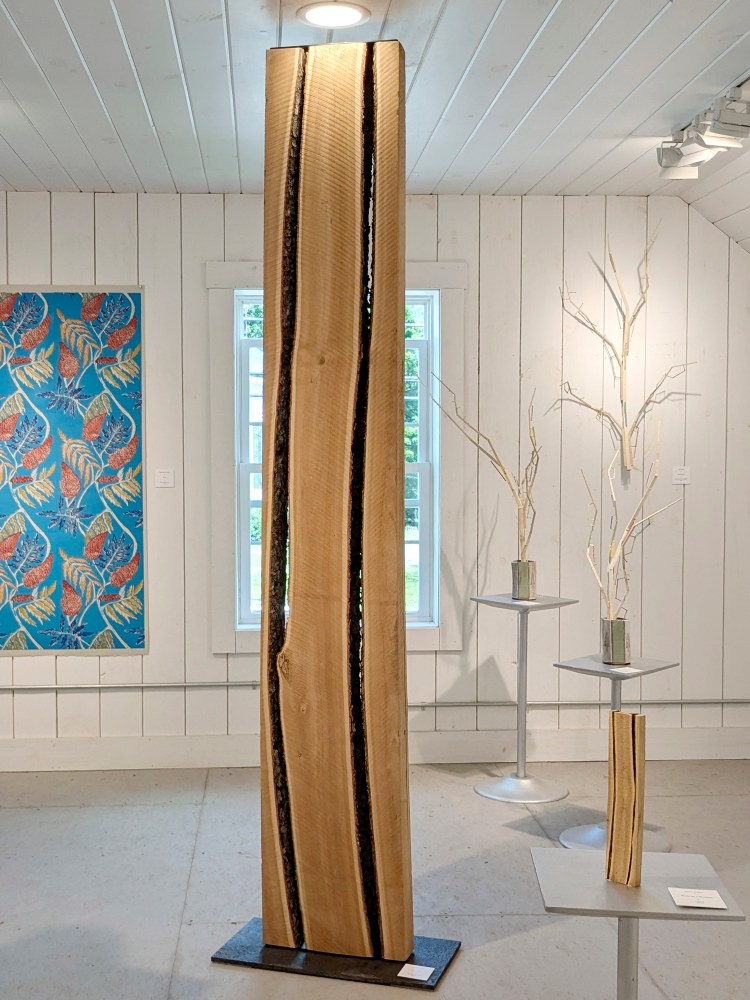

A sculpture by James Pullen at “Tree Talk.” Photo courtesy of Todd Watts
At the “imposing” end of the scale are Berenice Abbott’s “Banyan Tree” of 1954 (a nice inclusion, considering the Abbott show down the street) and the sculpture by Monson Arts’ educational coordinator James Pullen. The latter consists of planks shaved vertically from a tree, bark facing in and, facing out, the raw grained wood displaying the circular saw marks. It has a statuesque bearing in the gallery, its simplicity of form emanating a powerful presence while, simultaneously, its inside-out construction make it feel naked and vulnerable in a palpable way.
Behind it is a trio of Don Miller’s wonderfully inventive “Ash Branch” sculptures, in which he has constructed branch-like forms from lengths of ash then “rooted” them in repurposed wood-slat “pots.” Nails hammered shallowly into the branches support colorful rubber bands that give the impressions they are holding the branch forms together through tension. It’s this sort of quirkiness (along with Sam Margevicius’s hilarious “Picnic Table Tableau” photo and a lidded ceramic vessel by the gallery’s owner Jemma Gascoine that leans coquettishly to one side) that make the show delightful as well as substantial.
SKETCHY STORIES
Delightful is also a good word to use for Portland gallery Zero Station’s “Sketchbooks and Small Works – Artists New to the Gallery” (through Sept. 12). I say “delightful” because there is a recurring theme of play and improvisation to this show that immediately puts viewers in a lighthearted mood.
The methods used by these five artists – Crystal Crawley, Rebecca Hannon, Melissa Sweet, Ingrid Ellison and Eleanor Anderson – vary widely. There are traditional pencil sketches, colorful drawings, pieces collaged in a scrapbook-ish kind of way, stitched and embroidered fiber works, prisma color jewelry, artist books and more.
“Delightful” and “lighthearted” do not imply, however, that the works here are lightweight. Ingrid Ellison’s mixed media drawing with collaged elements, “Storm,” for example, conveys the dark, brooding – possibly even dangerous – moodiness of this weather phenomenon in a completely abstract way. Crystal Crawley’s “Ropy (aka The heart is a moody, greedy thing),” of handmade paper, embroidery and reconfigured found lithograph, looks elegant and composed, except that the litho of the heart has all the pulsing, corpuscular energy of a living organ that registers mercurial emotions that are sometimes virtuous (joy, love, kindness) and sometimes not (avarice, jealousy, contempt).
Sketches often imply something experimental, exploratory or unfinished. Contrary to that, however, is Ellison’s limited edition “Unique Artists Books,” which are beautifully handbound and illustrated accordion-fold books that have obviously been thought out and meticulously produced. Rebecca Hannon’s brooches and cuffs also look too expertly executed to be spontaneous and improvised.
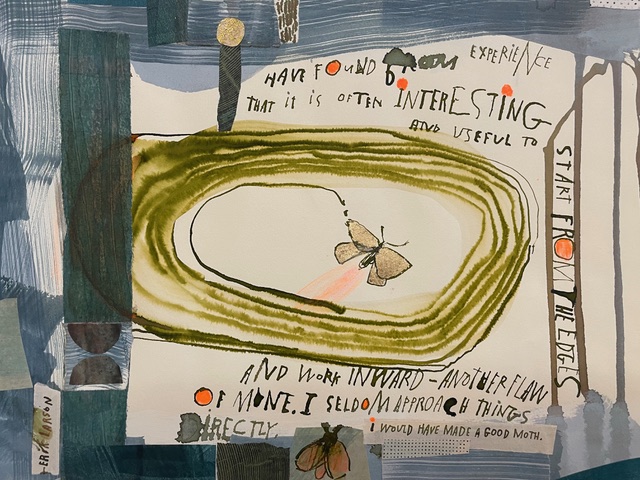

Melissa Sweet, “I would Have Made a Good Moth,” 2023 gouache and watercolor on paper, 9 x 12 inches Image courtesy of Zero Station
Melissa Sweet’s book illustrations and drawings mix in text – about the migration of seeds or the metamorphosis of moths, for example – that gives her drawings a poetic or literary quality.
My favorite works in the show are Anderson’s, if for no other reason than the freewheeling sense of adventurousness and spontaneous discovery – of media, form, color and concept. They span mixed media objects, glass, enamel, metal, textile, and a profusion of sketchbook drawings. Her “Ciphers 1-8” are mixed textile drawings, if you will, that riff on materials, colors and shapes that the artist seems to try to hold in place. Several resemble squares that have been stitched down or “taped” to their background with lengths of material. One appears like a snake whose slither is arrested by these tape-like swatches of fabric. Another seems like a brick wall fixed in place by red dot stickies. The push-pull of them feels playfully contradictory.
Jorge S. Arango has written about art, design and architecture for over 35 years. He lives in Portland. He can be reached at: jorge@jsarango.com
Copy the Story Link
Source link : http://www.bing.com/news/apiclick.aspx?ref=FexRss&aid=&tid=66d42f5218ac46b1b3c8c1a5400d0b4c&url=https%3A%2F%2Fwww.pressherald.com%2F2024%2F09%2F01%2Fat-3-maine-galleries-small-art-shows-help-usher-in-fall%2F&c=10529852573794661889&mkt=en-us
Author :
Publish date : 2024-08-31 21:01:00
Copyright for syndicated content belongs to the linked Source.
